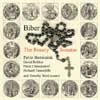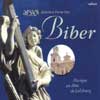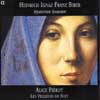Biber Mystery Sonatas
Biber’s virtuoso bent in his most lasting monument – and his sombre side
View record and artist detailsRecord and Artist Details
Composer or Director: Heinrich Ignaz Franz von Biber
Genre:
Chamber
Label: Avie
Magazine Review Date: 7/2004
Media Format: CD or Download
Media Runtime: 157
Mastering:
Stereo
DDD
Catalogue Number: AV0038

Tracks:
| Composition | Artist Credit |
|---|---|
| Mystery (Rosary) Sonatas and Passacaglia |
Heinrich Ignaz Franz von Biber, Composer
David Roblou, Harpsichord Heinrich Ignaz Franz von Biber, Composer Pavlo Beznosiuk, Violin Richard Tunnicliffe, Viola da gamba |
Composer or Director: Heinrich Ignaz Franz von Biber
Genre:
Vocal
Label: Ambroisie
Magazine Review Date: 7/2004
Media Format: CD or Download
Media Runtime: 50
Mastering:
Stereo
Catalogue Number: AMB9936

Tracks:
| Composition | Artist Credit |
|---|---|
| Requiem |
Heinrich Ignaz Franz von Biber, Composer
Arsys Bourgogne Heinrich Ignaz Franz von Biber, Composer Pierre Cao, Conductor |
| Ne cedite mentes |
Heinrich Ignaz Franz von Biber, Composer
Arsys Bourgogne Heinrich Ignaz Franz von Biber, Composer Pierre Cao, Conductor |
| Huc poenitentes |
Heinrich Ignaz Franz von Biber, Composer
Arsys Bourgogne Heinrich Ignaz Franz von Biber, Composer Pierre Cao, Conductor |
| Quo abiit dilectus |
Heinrich Ignaz Franz von Biber, Composer
Arsys Bourgogne Heinrich Ignaz Franz von Biber, Composer Pierre Cao, Conductor |
| Lux perpetua |
Heinrich Ignaz Franz von Biber, Composer
Arsys Bourgogne Heinrich Ignaz Franz von Biber, Composer Pierre Cao, Conductor |
Composer or Director: Heinrich Ignaz Franz von Biber
Genre:
Chamber
Label: Alpha
Magazine Review Date: 7/2004
Media Format: CD or Download
Media Runtime: 119
Catalogue Number: ALPHA038

Tracks:
| Composition | Artist Credit |
|---|---|
| Mystery (Rosary) Sonatas and Passacaglia |
Heinrich Ignaz Franz von Biber, Composer
(Les) Veilleurs de Nuit Heinrich Ignaz Franz von Biber, Composer |
Author: Richard Lawrence
Listening to all the sonatas at one sitting is not to be recommended, as there is a sameness about the pieces that could become wearying. Biber was a virtuoso on the violin, and he typically writes extended flourishes over a pedal point, at the start of a piece or approaching a final cadence. The abundant variation movements are always on an unchanging ground bass, with no overlapping of phrases in the violin to add interest and propel the music forward.
That there are still many things to enjoy is due to the excellence of Les Veilleurs de Nuit. Alice Piérot dashes off the pyrotechnics with fearsome ease, but she also brings the sensibility of a true musician to the more reflective passages such as the final Adagio of the third sonata (‘The Nativity’), which is both simple and heartfelt. She gives the impression of extemporising in the Praeludium of No 5 (‘The 12-year-old Jesus in the Temple’), and the dances skip along like the rams and young sheep of the psalmist.
Elisabeth Geiger plays the claviorganum, a hybrid beast comprising a harpsichord and a two-manual organ. The powerful tones of the latter lend special force to the sonatas reflecting the Agony in the Garden and the Crucifixion, and the occasional use of the four-foot stop on its own makes for a pleasing variety. But the finest piece is surely the unaccompanied Passacaglia (‘The Guardian Angel’), variations over a descending four-note phrase, which Alice Piérot dispatches with a perfect balance between architecture and emotion. The booklet includes five vignettes from the manuscript; it’s a pity that room couldn’t be found for all 16.
The Avie recording scores by including the complete set on the cover of the booklet. Each sonata is introduced by an exhortation from a Jesuit Rosary psalter, presumably translated from the Latin, read by Timothy West in tones ranging from the measured to the impassioned. The continuo group play in various permutations, one sonata being very effectively accompanied by a double-stopping gamba.
Other differences include a repeat of the sarabandes in two of the sonatas, and decorations from the lute interpolated into the opening phrases of ‘The Descent of the Holy Ghost’. Pavlo Beznosiuk is quite the equal of Alice Piérot in virtuosity and musicianship, and in his use of spiccato he introduces a positively skittish note to ‘The Coronation of Mary’. I slightly prefer the brisker approach of Alice Piérot in the Passacaglia, but there’s not much in it.
The main interest of the disc of choral music lies in the four offertories, three of them written for a saint’s day. The most attractive are Ne cedite montes and Lux perpetua, which show a welcome trans-Alpine warmth and grace. The solo singing is more than adequate, never outstanding.
The Requiem, like the offertories, is scored for soloists, chorus and strings, with sackbuts doubling the lower voices. It’s a sombre piece, all too seldom leaving the home key of F minor, and with word-setting that in places verges on the perfunctory. The ear is tickled by the rhythmic ambiguity of ‘Judex ergo’, but the rest is pretty unmemorable. Some may consider that the disc offers short measure but, believe me, 50 minutes are plenty.
Discover the world's largest classical music catalogue with Presto Music.

Gramophone Digital Club
- Digital Edition
- Digital Archive
- Reviews Database
- Full website access
From £8.75 / month
Subscribe
Gramophone Full Club
- Print Edition
- Digital Edition
- Digital Archive
- Reviews Database
- Full website access
From £11.00 / month
Subscribe
If you are a library, university or other organisation that would be interested in an institutional subscription to Gramophone please click here for further information.




